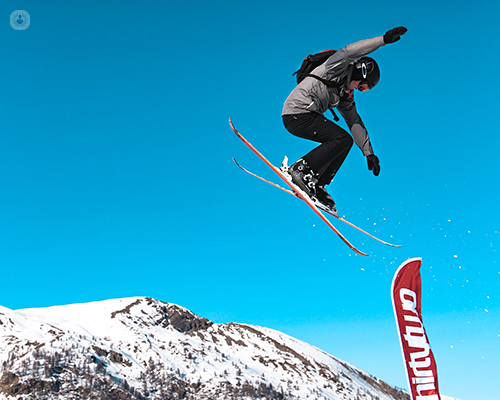Preventing snow sports injuries
Escrito por:Mr Sudhir Rao is a consultant orthopaedic surgeon with advanced skill and knowledge in treating sports-related injuries. Read on for his advice on staying as safe as possible when skiing and snowboarding.

If you haven’t yet read Mr Rao’s article on understanding skiing and snowboarding injuries, click here.
1. Use high-quality equipment
Better equipment has contributed to a drop in injuries. Foot bindings have evolved to lessen accidents that involve broken legs and helmets have become the norm.
When Michael Schumacher crashed, his helmet split in two but doctors said it probably saved his life. Some sources report no decrease in brain injuries from helmet use and other sources actively encourage helmet use. In the absence of definitive statistics, it seems celebrity tragedies are having more impact on the use of safety equipment than actual evidence.
2. Wear a helmet to reduce the risk of injury
The debate about whether or not to wear a helmet while skiing is a lively one.
- The American Association of Neurological Surgeons says that “the leading cause of death from sports-related injuries is traumatic brain injury.”
- According to research published in the journal of the Canadian Medical Association, “helmets reduce the risk of head injury among skiers and snowboarders”.
Of course, wearing a ski helmet will not guarantee your safety – especially if you ski off a cliff or if you hit a rock or a tree at high speed.
Other items of ski safety equipment to consider using include spine protectors for skiers, as well as padded shorts and wrist protectors for snowboarders, knee braces for those who have had previous knee surgery.
3. Be mindful of snow quality - poor snow quality makes skiing more dangerous
On piste, poor snow quality also increases the risk of injury. If the snow is hard-packed or icy, it’s harder to grip with your ski edges. This can cause more severe injuries on impact. It also causes most skiers to tense up, consequently reducing their fluency and control.
As a result, you should ski gentler slopes and reduce your speed when the snow is icy. A good rule of thumb is to trade down a piste level if conditions are poor.
4. Watch your speed
Confident athletic skiers can easily reach 60mph on a steep piste, but many skiers do not have the skills to control their descents at this speed and they’re a danger both to themselves and to other mountain users, who won’t see an out-of-control skier tearing towards them from behind.
The result is that 10% of all injuries on the slopes are the result of collisions with other mountain users. These collisions can be fatal, so reduce your speed, especially if the pistes are crowded.
5. Don’t ski when you’re drunk
Ski safety and excessive alcohol do not mix; boozy lunches and too much après-ski on the mountain have long contributed to the incomes of orthopaedic surgeons. Alcohol not only slows reactions, but also removes inhibitions, and skiers are likely to ski faster and more recklessly as a result. Big hangovers can also affect a skier’s performance (and safety) the following day, too.
In France, injured skiers may well find their breath analysed on arrival in hospital. And if you’re going to drink on the mountain, you should also check the small print of your insurance policy – you may not be covered in the event of an accident.
6. Get fit before you go
If your only exercise is walking the dog at weekends, you can hardly expect your body to cope on a ski holiday without complaint. Six hours a day of sustained exertion, at altitude, can take quite a toll, and many skiers consequently get profoundly tired.
It’s one of the reasons why the final hour of the day on the pistes is known as ‘insurance hour’. Tired legs and fuzzy, exhausted minds are a contributing factor to the high incidence of accidents in the final minutes before the lifts close.
Fortunately, the remedy is simple. You have to accept that skiing is a sport – not the winter equivalent of relaxing by the pool on a sun lounger – and follow a ski fitness programme before your holiday to prepare you for the physical strain.
7. Handle terrain parks with care
Terrain parks are a staple feature of the modern ski resort and their jumps, half-pipes, rails and boxes are the setting for daily displays of acrobatic skill and courage. In fact, according to research described in ski-injuries.com, skiers and snowboarders tend to sustain more serious injuries in terrain parks than elsewhere on the mountain – and are more likely to require an ambulance.
Individuals injured in a terrain park are also “more likely to sustain head/face, back and neck injuries and are less likely to sustain upper limb injuries” than other skiers or snowboarders. Given that the greatest single cause of injury in this environment is a fall from a great height, perhaps this isn’t so surprising.
There are all sorts of elements of terrain-park safety. For a start, skiers should wear protective equipment – including helmets and spine protectors.
Snowboarders need wrist protectors and padded shorts, too. But what’s just as important is to scale back their ambition to match their skills. This means picking beginner-friendly features to practice on when they’re new to freestyle skiing and mastering the basics of good jumping before they try anything complicated.
In North America, terrain parks routinely produce codes of conduct, which you should study and absorb before you ski.
8. Be cautious off-piste
Michael Schumacher’s accident took place off-piste – but it wasn’t on some faraway backcountry descent. He fell on a scrap of terrain between two pistes and this serves as a reminder to all skiers of the risks of leaving groomed and waymarked trails.
- Hire a qualified and experienced local guide.
- Never put your guide under pressure to provide you with an “epic powder day”. Give him or her space and time to make safety your priority.
- Ensure every member of the party carries avalanche safety equipment and that they are trained on its use. The essentials are avalanche transceiver, shovel, probe, mobile phone and a first-aid kit. Ideally, every member of the party should carry an avalanche airbag rucksack too.
- Always read local and regional avalanche bulletins yourself, and discuss the risks in detail with your guide.
- Get your own off-piste skiing training – such as that offered by HAT in Val d’Isere and Tignes, and SAAC in Austria – so you can begin to evaluate the dangers yourself.
9. Never travel without ski insurance
Poor fitness, poor selection of terrain or conditions, poor judgement of one’s ability, or poor maintenance of equipment are factors in many injuries. The take-home message is that many skiing and snowboarding injuries are preventable.
Visit Mr Rao’s Top Doctors profile to learn more about the treatment and management of orthopaedic injuries, and to get in touch.



